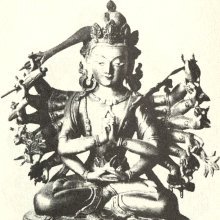Shodashabhuja, Ṣoḍaśabhujā, Shodashan-bhuja: 6 definitions
Introduction:
Shodashabhuja means something in Hinduism, Sanskrit. If you want to know the exact meaning, history, etymology or English translation of this term then check out the descriptions on this page. Add your comment or reference to a book if you want to contribute to this summary article.
The Sanskrit term Ṣoḍaśabhujā can be transliterated into English as Sodasabhuja or Shodashabhuja, using the IAST transliteration scheme (?).
Images (photo gallery)
In Hinduism
Pancaratra (worship of Nārāyaṇa)
Source: University of Vienna: Sudarśana's Worship at the Royal Court According to the AhirbudhnyasaṃhitāṢoḍaśabhuja (षोडशभुज) refers to “sixteen-armed”, according to the Ahirbudhnyasaṃhitā, belonging to the Pāñcarātra tradition which deals with theology, rituals, iconography, narrative mythology and others.—Accordingly, “When kings are overpowered by enemies with an army (or: by strong enemies), when cities are burnt down and the Kings’ army is driven away, when people in various districts do not have access to food [and other goods]—if the kingdom is thus oppressed by the enemies’ army, oh Great Sage, and if in this inadequate situation the King’s enemies are unimpeded, he should have a sixteen-armed (ṣoḍaśabhuja) Sudarśana constructed [and properly installed, for his power is] without obstacles”.

Pancaratra (पाञ्चरात्र, pāñcarātra) represents a tradition of Hinduism where Narayana is revered and worshipped. Closeley related to Vaishnavism, the Pancaratra literature includes various Agamas and tantras incorporating many Vaishnava philosophies.
Shaktism (Shakta philosophy)
Source: Google Books: ManthanabhairavatantramṢoḍaśabhuja (षोडशभुज) refers to “(having) sixteen arms”, according to the Manthānabhairavatantra, a vast sprawling work that belongs to a corpus of Tantric texts concerned with the worship of the goddess Kubjikā.—Accordingly, “Now I will tell (you) the teaching concerning Gurunātha, merely by knowing which the tradition of the teachers functions. [...] O god, (he is) associated with the eighty-one parts (of Navātman) and has eight lotus-like faces and sixteen arms (ṣoḍaśabhuja—ṣoḍaśaiś ca bhujair). (This is the) Sakala (form of the teacher), which is endowed with energy. Each part of (his) body is (like a shining) lamp within (his) maṇḍalas. (He is) the first teacher adorned with the Krama and (accompanied) by the Siddha couples of the Transmental (that constitutes the Divine Current). [...]”.

Shakta (शाक्त, śākta) or Shaktism (śāktism) represents a tradition of Hinduism where the Goddess (Devi) is revered and worshipped. Shakta literature includes a range of scriptures, including various Agamas and Tantras, although its roots may be traced back to the Vedas.
Languages of India and abroad
Sanskrit dictionary
Source: DDSA: The practical Sanskrit-English dictionaryṢoḍaśabhujā (षोडशभुजा).—a form of Durgā.
Ṣoḍaśabhujā is a Sanskrit compound consisting of the terms ṣoḍaśan and bhujā (भुजा).
Source: Cologne Digital Sanskrit Dictionaries: Shabda-Sagara Sanskrit-English DictionaryṢoḍaśabhujā (षोडशभुजा).—f.
(-jā) A form of Durga.
Source: Cologne Digital Sanskrit Dictionaries: Monier-Williams Sanskrit-English Dictionary1) Ṣoḍaśabhuja (षोडशभुज):—[=ṣoḍaśa-bhuja] [from ṣoḍaśa > ṣaṣ] mfn. 16-armed
2) Ṣoḍaśabhujā (षोडशभुजा):—[=ṣoḍaśa-bhujā] [from ṣoḍaśa-bhuja > ṣoḍaśa > ṣaṣ] f. a form of Durgā, [Kālikā-purāṇa]
[Sanskrit to German]
Sanskrit, also spelled संस्कृतम् (saṃskṛtam), is an ancient language of India commonly seen as the grandmother of the Indo-European language family (even English!). Closely allied with Prakrit and Pali, Sanskrit is more exhaustive in both grammar and terms and has the most extensive collection of literature in the world, greatly surpassing its sister-languages Greek and Latin.
See also (Relevant definitions)
Partial matches: Shodasha, Bhuja.
Starts with: Shodashabhujaramadhyana.
Full-text: Shodashabhujaramadhyana, Shodasha.
Relevant text
No search results for Shodashabhuja, Ṣoḍaśabhujā, Shodashan-bhuja, Ṣoḍaśan-bhujā, Sodasabhuja, Sodasan-bhuja, Ṣoḍaśabhuja, Shodasha-bhuja, Ṣoḍaśa-bhuja, Sodasa-bhuja, Ṣoḍaśa-bhujā; (plurals include: Shodashabhujas, Ṣoḍaśabhujās, bhujas, bhujās, Sodasabhujas, Ṣoḍaśabhujas) in any book or story.
